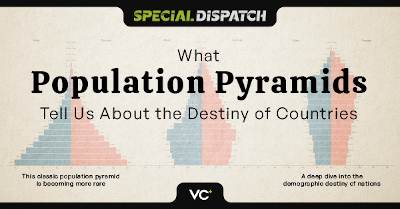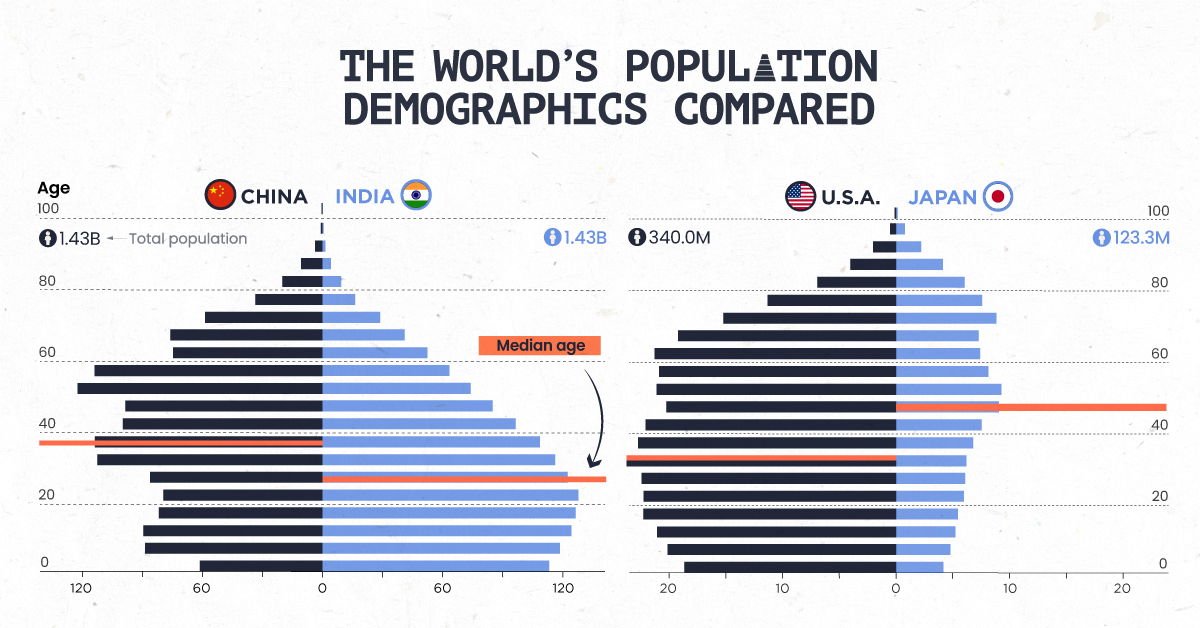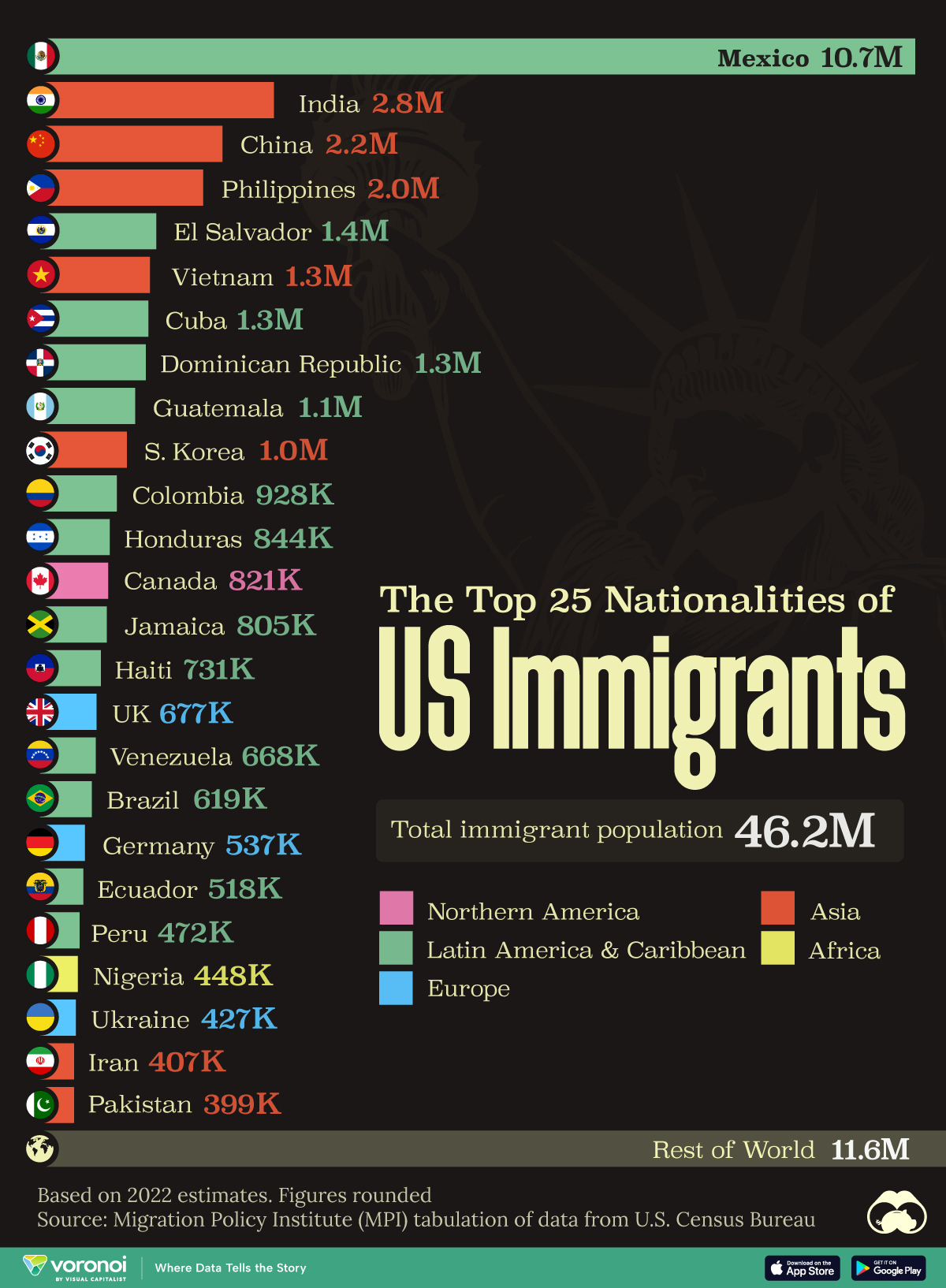Misc
Comparing Population Pyramids Around the World
Now Available, Exclusively to VC+ Members.
Dive deeper into what affects the demographics of global economies. Join VC+ to get our special dispatch!
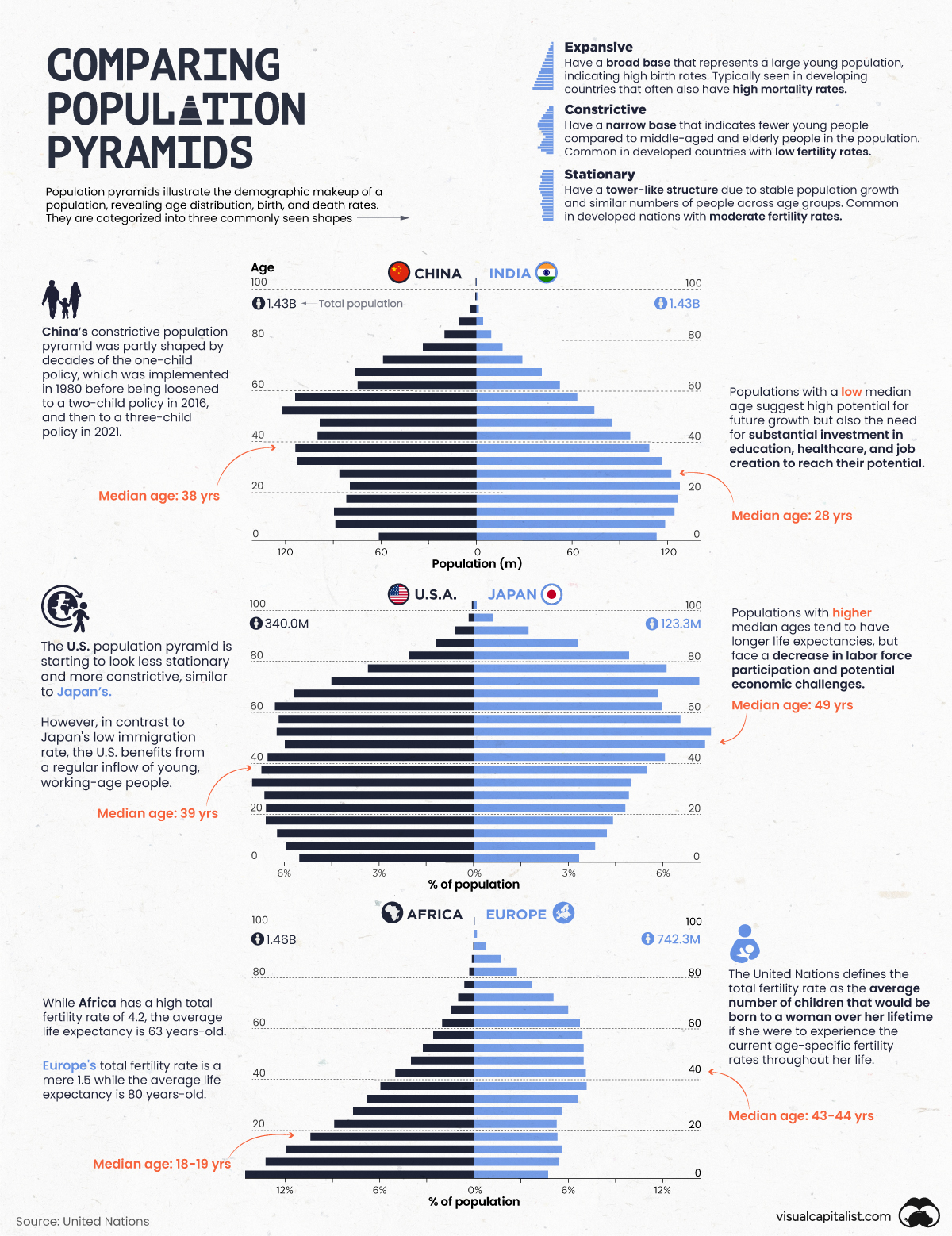
Understanding and Comparing Population Pyramids
Demographic data can reveal all kinds of insights about a population, from the country’s fertility and mortality rates to how certain events and policies have shaped the makeup of a population.
Population pyramids are one of the best ways to visualize population data, and comparing the pyramids of various countries and regions side-by-side can reveal unexpected insights and differences between groups.
This graphic uses population data from the United Nations to compare the demographics of some select nations and regions of the world, showcasing how much age distributions can vary.
Three Types of Population Pyramids
Although population pyramids can come in all shapes and sizes, most generally fall into three distinct categories:
- Expansive Pyramids: Recognized by their traditional “pyramid-like” shape with a broad base and narrow top, expansive pyramids reflect a population with a high birth rate along with a high mortality rate which is most common in developing countries.
- Constrictive Pyramids: With a narrow base and thicker middle and top sections of the pyramid, constrictive pyramids often occur in developed economies whose populations have low birth rates and long life expectancies.
- Stationary Pyramids: These pyramids showcase an evenly distributed population across age groups, often found in newly-developed countries which have stable birth and mortality rates.
Each population pyramid is essentially a visual snapshot of a nation’s current demographic breakdown, shaped by fluctuating birth and mortality rates as well as changes to immigration and social policies.
Understanding the inherent risks associated with different pyramid types can help give insight into the challenges these populations face.
The Risks of Different Population Pyramid Types
Each type of population pyramid structure has unique challenges and advantages often characterized by the country or region’s current stage of economic development.
Populations with expansive pyramids, such as the one representing the continent of Africa, have the advantage of a larger youth and working-aged population, however this advantage can be rendered null if job growth, education, and health care aren’t prioritized.
Countries with constrictive pyramids like Japan face the challenge of supporting their outsized aging population with a diminishing working-aged population. While immigration and increasing birth rates can help in both the short and long term, due to the working population being outnumbered, countries with constrictive pyramids must find ways to increase their productivity to avoid potential declines in economic growth.
China and India’s Demographics Compared
After the world’s population reached eight billion people last year, 2023 brought a new population milestone as India overtook China as the world’s most populous country.
When you compare the two nations’ population pyramids, you can see how India’s population has a strong base of young and working-aged people compared to China’s more constrictive population pyramid that also features a higher median age.
This demographic difference is largely shaped by China’s one-child policy which since 2021 was loosened to be a three-child policy. As a result, China’s total fertility rate is around 1.2 today, in contrast to India’s total fertility rate of 2.0.
While India is set to ride the productivity boom of its large working-age population, the country will have to ensure it can keep its population pyramid stable as the majority of the population ages and total fertility rates continue to decline.
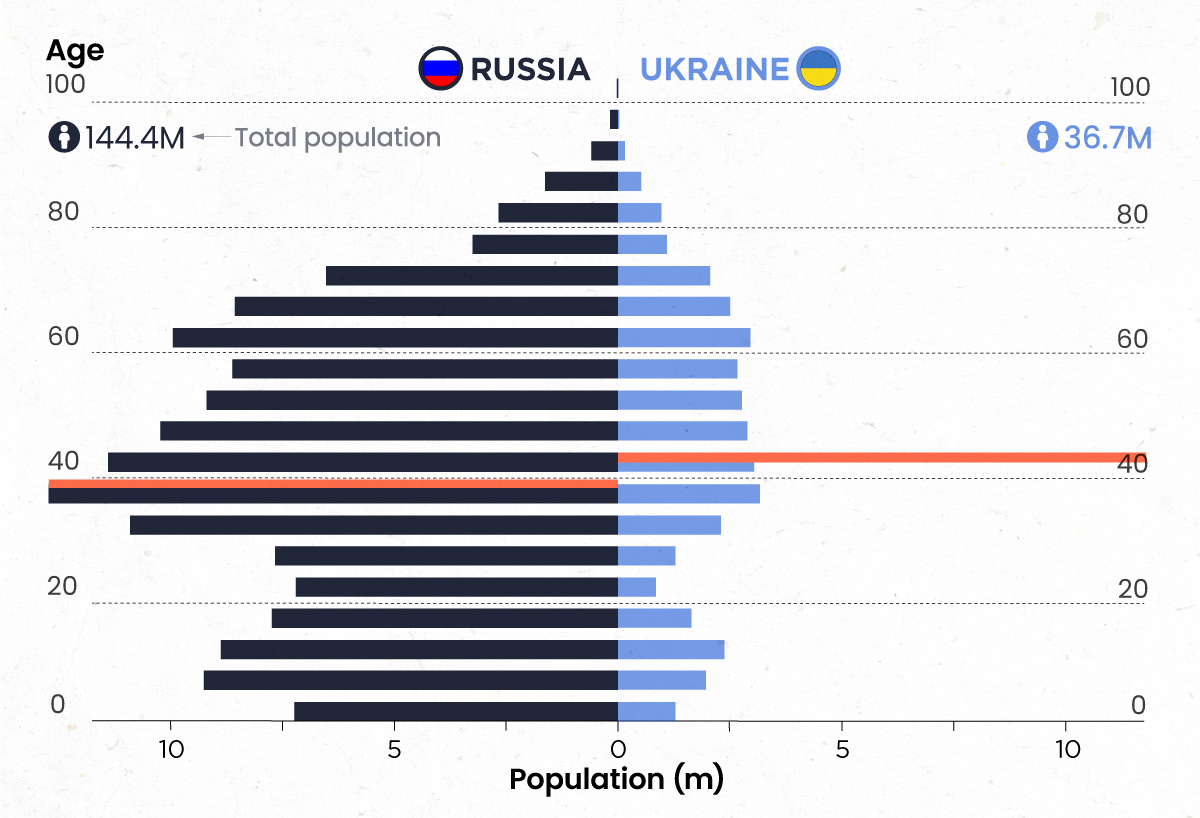 |
Interested in learning more about the various factors that affect demographics?
VC+ Members get an exclusive look comparing the G7 and BRICS nations, how war shapes population pyramids, and immigration’s role in demographics. Unlock this in-depth briefing and hundreds of other visual insights with our newly available VC+ Archive. |
Misc
The Top 25 Nationalities of U.S. Immigrants
Mexico is the largest source of immigrants to the U.S., with almost 11 million immigrants.
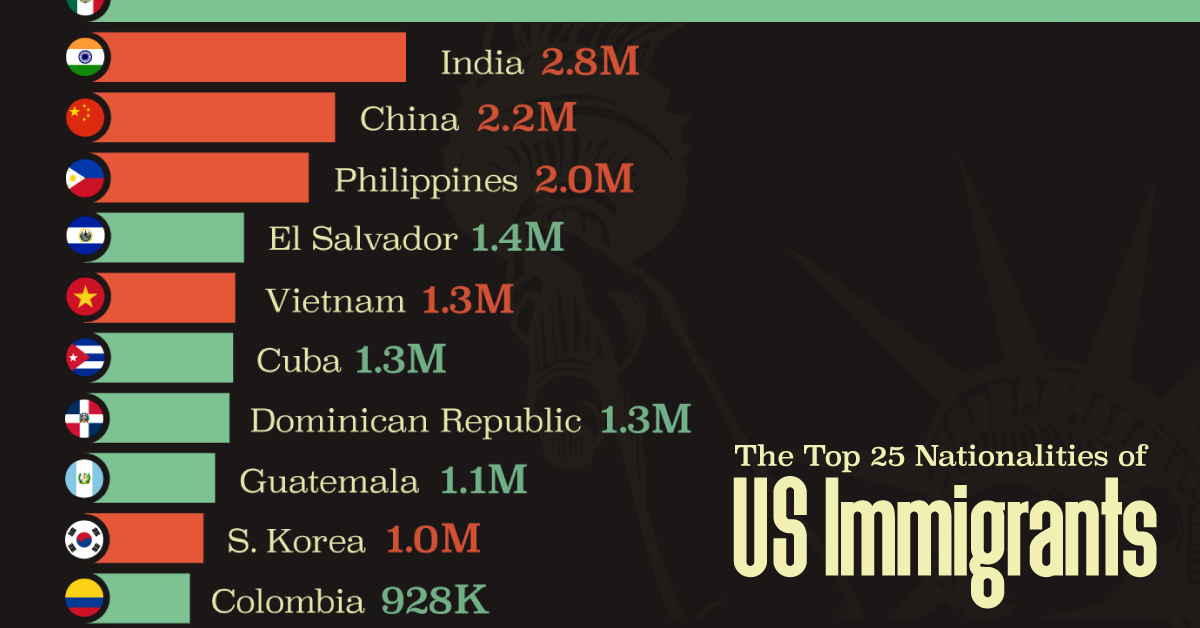
The Top 25 Nationalities of U.S. Immigrants
This was originally posted on our Voronoi app. Download the app for free on iOS or Android and discover incredible data-driven charts from a variety of trusted sources.
The United States is home to more than 46 million immigrants, constituting approximately 14% of its total population.
This graphic displays the top 25 countries of origin for U.S. immigrants, based on 2022 estimates. The data is sourced from the Migration Policy Institute (MPI), which analyzed information from the U.S. Census Bureau’s 2022 American Community Survey.
In this context, “immigrants” refer to individuals residing in the United States who were not U.S. citizens at birth.
Mexico Emerges as a Leading Source of Immigration
Mexico stands out as the largest contributor to U.S. immigration due to its geographical proximity and historical ties.
Various economic factors, including wage disparities and employment opportunities, motivate many Mexicans to seek better prospects north of the border.
| Country | Region | # of Immigrants |
|---|---|---|
| 🇲🇽 Mexico | Latin America & Caribbean | 10,678,502 |
| 🇮🇳 India | Asia | 2,839,618 |
| 🇨🇳 China | Asia | 2,217,894 |
| 🇵🇭 Philippines | Asia | 1,982,333 |
| 🇸🇻 El Salvador | Latin America & Caribbean | 1,407,622 |
| 🇻🇳 Vietnam | Asia | 1,331,192 |
| 🇨🇺 Cuba | Latin America & Caribbean | 1,312,510 |
| 🇩🇴 Dominican Republic | Latin America & Caribbean | 1,279,900 |
| 🇬🇹 Guatemala | Latin America & Caribbean | 1,148,543 |
| 🇰🇷 Korea | Asia | 1,045,100 |
| 🇨🇴 Colombia | Latin America & Caribbean | 928,053 |
| 🇭🇳 Honduras | Latin America & Caribbean | 843,774 |
| 🇨🇦 Canada | Northern America | 821,322 |
| 🇯🇲 Jamaica | Latin America & Caribbean | 804,775 |
| 🇭🇹 Haiti | Latin America & Caribbean | 730,780 |
| 🇬🇧 United Kingdom | Europe | 676,652 |
| 🇻🇪 Venezuela | Latin America & Caribbean | 667,664 |
| 🇧🇷 Brazil | Latin America & Caribbean | 618,525 |
| 🇩🇪 Germany | Europe | 537,484 |
| 🇪🇨 Ecuador | Latin America & Caribbean | 518,287 |
| 🇵🇪 Peru | Latin America & Caribbean | 471,988 |
| 🇳🇬 Nigeria | Africa | 448,405 |
| 🇺🇦 Ukraine | Europe | 427,163 |
| 🇮🇷 Iran | Middle East | 407,283 |
| 🇵🇰 Pakistan | Asia | 399,086 |
| Rest of World | 11,637,634 | |
| Total | 46,182,089 |
Mexicans are followed in this ranking by Indians, Chinese, and Filipinos, though most immigrants on this list come from countries in the Latin American and Caribbean region.
On the other hand, only three European countries are among the top sources of U.S. immigrants: the UK, Germany, and Ukraine.
Immigration continues to be a significant factor contributing to the overall growth of the U.S. population. Overall population growth has decelerated over the past decade primarily due to declining birth rates.
Between 2021 and 2022, the increase in the immigrant population accounted for 65% of the total population growth in the U.S., representing 912,000 individuals out of nearly 1.4 million.
If you enjoyed this post, be sure to check out Visualized: Why Do People Immigrate to the U.S.? This visualization shows the different reasons cited by new arrivals to America in 2021.
-

 Personal Finance1 week ago
Personal Finance1 week agoVisualizing the Tax Burden of Every U.S. State
-

 Misc6 days ago
Misc6 days agoVisualized: Aircraft Carriers by Country
-

 Culture6 days ago
Culture6 days agoHow Popular Snack Brand Logos Have Changed
-

 Mining1 week ago
Mining1 week agoVisualizing Copper Production by Country in 2023
-

 Misc1 week ago
Misc1 week agoCharted: How Americans Feel About Federal Government Agencies
-

 Healthcare1 week ago
Healthcare1 week agoWhich Countries Have the Highest Infant Mortality Rates?
-

 Demographics1 week ago
Demographics1 week agoMapped: U.S. Immigrants by Region
-

 Maps1 week ago
Maps1 week agoMapped: Southeast Asia’s GDP Per Capita, by Country

